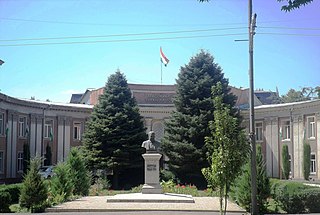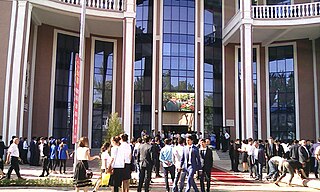Related Research Articles

Tajikistan, officially the Republic of Tajikistan, is a landlocked country in Central Asia. Dushanbe is the capital and most populous city. Tajikistan is bordered by Afghanistan to the south, Uzbekistan to the west, Kyrgyzstan to the north, and China to the east. It is separated from Pakistan by Afghanistan's Wakhan Corridor. It has a population of approximately 10.6 million people.

Tajiks are a Persian-speaking Iranian ethnic group native to Central Asia, living primarily in Afghanistan, Tajikistan, and Uzbekistan. Tajiks are the largest ethnicity in Tajikistan, and the second-largest in Afghanistan and Uzbekistan. More Tajiks live in Afghanistan than Tajikistan. They speak varieties of Persian, a Western Iranian language. In Tajikistan, since the 1939 Soviet census, its small Pamiri and Yaghnobi ethnic groups are included as Tajiks. In China, the term is used to refer to its Pamiri ethnic groups, the Tajiks of Xinjiang, who speak the Eastern Iranian Pamiri languages. In Afghanistan, the Pamiris are counted as a separate ethnic group.

Dushanbe is the capital and largest city of Tajikistan. As of March 2024, Dushanbe had a population of 1,564,700, with this population being largely Tajik. Until 1929, the city was known in Russian as Dyushambe, and from 1929 to 1961 as Stalinabad, after Joseph Stalin. Dushanbe is located in the Gissar Valley, bounded by the Gissar Range in the north and east and the Babatag, Aktau, Rangontau and Karatau mountains in the south, and has an elevation of 750–930 m. The city is divided into four districts: Ismail Samani, Avicenna, Ferdowsi, and Shah Mansur.

Emomali Rahmon is a Tajik politician who has served as the President of Tajikistan since 1994, having previously led the country as Chairman of the Supreme Assembly from 1992 to 1994.

The Tajik Soviet Socialist Republic, also commonly known as Soviet Tajikistan, the Tajik SSR, TaSSR, or simply Tajikistan, was one of the constituent republics of the Soviet Union which existed from 1929 to 1991 in Central Asia.

Bokhtar, previously known as Qurghonteppa, Kurganteppa and Kurgan-Tyube, is a city in southwestern Tajikistan, which serves as the capital of the Khatlon region. Bokhtar is the largest city in southern Tajikistan, and is located 100 kilometres (62 mi) south of Dushanbe and 150 kilometres (93 mi) north of Kunduz, Afghanistan.

Gorno-Badakhshan, officially the Badakhshan Mountainous Autonomous Region, is an autonomous region in eastern Tajikistan, in the Pamir Mountains. It makes up nearly forty-five percent of the country's land area but only two percent of its population.

The Tajikistani Civil War, also known as the Tajik Civil War, began in May 1992 and ended in June 1997. Regional groups from the Garm and Gorno-Badakhshan regions of Tajikistan rose up against the newly formed government of President Rahmon Nabiyev, which was dominated by people from the Khujand and Kulob regions. The rebel groups were led by a combination of liberal democratic reformers and Islamists, who would later organize under the banner of the United Tajik Opposition. The government was supported by Russian military and border guards.

The Supreme Assembly of the Republic of Tajikistan, also known simply as the Majlisi Oli, is the parliament of Tajikistan.

The Tajik Aluminium Company, abbreviated as TALCO headquartered in Tursunzoda, Tajikistan, runs the largest aluminium manufacturing plant in Central Asia, and is Tajikistan's chief industrial asset.

TALCO Arena is a multi-use stadium in Tursunzoda, Tajikistan. It is currently used mostly for football matches and serves as the home of Regar-TadAZ Tursunzoda of the Tajik League. The stadium has a capacity of 13 770 people. Until 2017 it was called the stadium "Metallurg".

The Palace of Unity, also referred to as Vahdat Palace, is a building in Dushanbe, Tajikistan. Located in the northern part of Dushanbe's main thoroughfare, Rudaki Avenue, near Hotel Avesto and the embassy of Uzbekistan, it is the headquarters of the ruling People's Democratic Party and is also used to host international conferences.
This page examines the dynamics surrounding women in Tajikistan.

Academy of Sciences of the Republic of Tajikistan incorporates 20 research institutes and three territorial groupings: the Pamir Branch in the eastern part of the country, the Khujand Scientific Center in the north, and the Khatlon Scientific Center in the south-west. The Academy is organized in three thematic divisions: physico-mathematical, chemical, and geological sciences; biological and medical sciences; humanities and social sciences. The incumbent president is Academician M.I. Ilolov, elected in 2005.

Tajik Agrarian University 'S. Shotemur' (TAU) is a university in Tajikistan, in the capital of Dushanbe.

Russian-Tajik Slavonic University (RTSU), also known as Russian-Tajik University, is a university in Tajikistan located in Dushanbe. University was result of cooperation of Russian and Tajik governments. The majority of the students come from Russian families living in Tajikistan and the others are from Tajik and Uzbek families. The university is a member of the Euroasian Universities Association (EUA). Besides being Russian-Tajik the university has students in many nationalities including Armenian, Georgian, Ukrainian and others from Post-Soviet states.

Istiqlol is a city in Tajikistan, located in Sughd Region. Istiqlol is a city of regional subordination, administratively subordinated to the regional capital of Khujand.

The Arbob Cultural Palace is a building in Khujand, Tajikistan, the former headquarters of a Soviet collective farm, built in the 1950s and modelled on the winter gardens of Peterhof, St Petersburg.

Rudaki Avenue is the main thoroughfare street in Dushanbe, the capital of Tajikistan. The street is named after Rudaki, the Tajik national poet. The street was known as Lenin Avenue during the Soviet period, and used to host a statue of Vladimir Lenin. The street received its current name in the summer of 1992.

The Assembly of Representatives is the lower house of the bicameral Supreme Assembly of Tajikistan. The People's Democratic Party of Tajikistan has been the dominant party in the legislature since 2000.